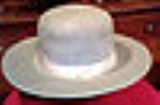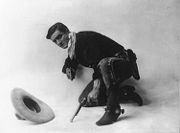
Boss of the plains
Encyclopedia

Hat
A hat is a head covering. It can be worn for protection against the elements, for ceremonial or religious reasons, for safety, or as a fashion accessory. In the past, hats were an indicator of social status...
designed by John B. Stetson
John Batterson Stetson
John Batterson Stetson was a U.S. hatter, hat manufacturer, and, in the 1860s, the inventor of the cowboy hat. He founded the John B. Stetson Company as a manufacturer of headwear; the company's hats are now commonly referred to simply as Stetsons.John Stetson was born in New Jersey, the 7th of...
for the demands of the American west. It was intended to be durable, waterproof and elegant. This design, and the term "Stetson
Stetson
Stetsons are the brand of hat manufactured by the John B. Stetson Company of St. Joseph, Missouri.Stetson eventually became the world’s largest hat maker, producing over 3.3 million hats a year in a factory spread over . Today Stetson remains a family-owned concern...
," eventually became all-but-interchangeable with what later became known as the cowboy hat
Cowboy hat
The cowboy hat is a high-crowned, wide-brimmed hat best known as the defining piece of attire for the North American cowboy. Today it is worn by many people, and is particularly associated with ranch workers in the western and southern United States, western Canada and northern Mexico, with...
.
Beginnings
The Boss had all the refinements of the world’s most elegant hats. The hat band was used to tighten the hat, with the knot on the left side to keep out of the way. The brim was stiff enough to lie flat. Inside the tie-string, a bow was placed on the back of a gold stamped sweatband, and a lining was included to protect the hat. The weather-resistant materials used both then and now, were expensive, difficult to obtain, and required many hours of skillful handling to create a quality hat.Design

For years, Stetson worried about the waterproofing, and finally decided to make his hat of beaver
Beaver
The beaver is a primarily nocturnal, large, semi-aquatic rodent. Castor includes two extant species, North American Beaver and Eurasian Beaver . Beavers are known for building dams, canals, and lodges . They are the second-largest rodent in the world...
felt. It took about 42 beaver belly pelts
Fur
Fur is a synonym for hair, used more in reference to non-human animals, usually mammals; particularly those with extensives body hair coverage. The term is sometimes used to refer to the body hair of an animal as a complete coat, also known as the "pelage". Fur is also used to refer to animal...
to produce a high quality hat. Because of the tight weave of most Stetson hats, it was waterproof enough to be used as a bucket
Bucket
A bucket, also called a pail, is typically a watertight, vertical cylinder or truncated cone, with an open top and a flat bottom, usually attached to a semicircular carrying handle called the bail. A pail can have an open top or can have a lid....
. One story tells of a cowboy
Cowboy
A cowboy is an animal herder who tends cattle on ranches in North America, traditionally on horseback, and often performs a multitude of other ranch-related tasks. The historic American cowboy of the late 19th century arose from the vaquero traditions of northern Mexico and became a figure of...
crossing a long dry stretch of prairie. His canteen
Canteen (bottle)
A canteen is a drinking water bottle designed to be used by hikers, campers, soldiers and workers in the field. It is usually fitted with a shoulder strap or means for fastening it to a belt, and may be covered with a cloth bag and padding to protect the bottle and insulate the contents...
sprung a leak. He saved the drinking water by carrying it in his Stetson. Stetson featured advertising of a cowboy
Cowboy
A cowboy is an animal herder who tends cattle on ranches in North America, traditionally on horseback, and often performs a multitude of other ranch-related tasks. The historic American cowboy of the late 19th century arose from the vaquero traditions of northern Mexico and became a figure of...
watering his horse with water carried in the crown. The wearer could also use the brim to direct water to a person's mouth. A high quality hat in good condition was also viewed in some places as a status symbol.
Customization and change


Thus, the manufactured styles also began to change. The first popular modification was a long crease sloping from the high back down towards the front, called the "Carlsbad crease" after a style used by wearers in Carlsbad, New Mexico. Another design, derived from the pointed top of the Mexican sombrero
Sombrero
Sombrero in English refers to a type of wide-brimmed hat originating in Mexico. In Spanish, however, it is the generic word for "hat", which originates from "sombra", meaning "shade"....
worked its way north and became known as the "Montana peak," which had four dents, originally derived from being handled on top with four fingers.
Popularization
Entertainers who promoted cowboy and western culture in the late 19th century and early 20th century popularized Stetson designs. For example, Buffalo BillBuffalo Bill
William Frederick "Buffalo Bill" Cody was a United States soldier, bison hunter and showman. He was born in the Iowa Territory , in LeClaire but lived several years in Canada before his family moved to the Kansas Territory. Buffalo Bill received the Medal of Honor in 1872 for service to the US...
had custom hats with very wide brims made for his Wild West Shows
Wild West Shows
Wild West Shows were traveling vaudeville performances in the United States and Europe. The first and prototypical wild west show was Buffalo Bill's, formed in 1883 and lasting until 1913...
, with later designs created for Hollywood including the Tom Mix
Tom Mix
Thomas Edwin "Tom" Mix was an American film actor and the star of many early Western movies. He made a reported 336 films between 1910 and 1935, all but nine of which were silent features...
style "ten-gallon" hats used in Western films
Western (genre)
The Western is a genre of various visual arts, such as film, television, radio, literature, painting and others. Westerns are devoted to telling stories set primarily in the latter half of the 19th century in the American Old West, hence the name. Some Westerns are set as early as the Battle of...
.
Over time, the working cowboy hat of the ranch
Ranch
A ranch is an area of landscape, including various structures, given primarily to the practice of ranching, the practice of raising grazing livestock such as cattle or sheep for meat or wool. The word most often applies to livestock-raising operations in the western United States and Canada, though...
cowboy, as modified by popular entertainers and rodeo
Rodeo
Rodeo is a competitive sport which arose out of the working practices of cattle herding in Spain, Mexico, and later the United States, Canada, South America and Australia. It was based on the skills required of the working vaqueros and later, cowboys, in what today is the western United States,...
competitors, became an essential part of the cowboy image. At times, various politicians, celebrities and certain law enforcement units adopted descendants of the Boss of the plains hat to strengthen their association with the culture and values of the Old West. The Boss of the plains-inspired design that became the modern cowboy hat has remained basically unchanged in construction and design since the first one created in 1865, demonstrating the degree to which form succeeded in following function.
See also
- CharroCharroCharro is a term referring to a traditional horseman from Mexico, originating in the central-western regions primarily in the state of Jalisco including: Zacatecas, Durango, Guanajuato, Morelos, Puebla...
- ChupallaChupallaThe chupalla is a traditional Chilean horseman's hat made of straw. Many people in rural areas of Central Chile use it as well. In addition, it is often used when dancing the cueca and during Chilean rodeos....
- CowboyCowboyA cowboy is an animal herder who tends cattle on ranches in North America, traditionally on horseback, and often performs a multitude of other ranch-related tasks. The historic American cowboy of the late 19th century arose from the vaquero traditions of northern Mexico and became a figure of...
- Cowboy hatCowboy hatThe cowboy hat is a high-crowned, wide-brimmed hat best known as the defining piece of attire for the North American cowboy. Today it is worn by many people, and is particularly associated with ranch workers in the western and southern United States, western Canada and northern Mexico, with...
- Equestrian helmet
- HatHatA hat is a head covering. It can be worn for protection against the elements, for ceremonial or religious reasons, for safety, or as a fashion accessory. In the past, hats were an indicator of social status...
s - HatterHatterA hatter is a person engaged in hatmaking.Hatter also may refer to:*The Hatter, a fictional character in Alice's Adventures in Wonderland* Luton Town F.C., team a.k.a. "The Hatters"* Stockport County F.C., team a.k.a. "The Hatters"...
- John B. Stetson CompanyJohn B. Stetson CompanyThe John B. Stetson Company, founded by John B. Stetson in 1865, was the maker of the Stetson cowboy hats, but ceased manufacturing in 1970. Stetson hats are now being manufactured in Garland, Texas by Hatco Inc who also produce Resistol, and Charlie 1 Horse, hats. Stetson reentered manufacturing...
- List of headgear
- RanchRanchA ranch is an area of landscape, including various structures, given primarily to the practice of ranching, the practice of raising grazing livestock such as cattle or sheep for meat or wool. The word most often applies to livestock-raising operations in the western United States and Canada, though...
- SombreroSombreroSombrero in English refers to a type of wide-brimmed hat originating in Mexico. In Spanish, however, it is the generic word for "hat", which originates from "sombra", meaning "shade"....
- StetsonStetsonStetsons are the brand of hat manufactured by the John B. Stetson Company of St. Joseph, Missouri.Stetson eventually became the world’s largest hat maker, producing over 3.3 million hats a year in a factory spread over . Today Stetson remains a family-owned concern...
- Western wearWestern wearWestern wear is a category of men's and women's clothing which derives its unique style from the clothes worn in the 19th-century American West. It ranges from accurate historical reproductions of pioneer, mountain man, Civil War, cowboy and vaquero clothing to the stylized garments popularized by...
Footnotes
External links
- curtrich.com, in search of the real cowboy hat, Cowboy Chronicle April 2004 reprint, accessed online April 1, 2009.
- deathvalley49ers.org, John B. Stetson Hat Co. to revive, the famed ‘Boss of the Plains’ hat, accessed online April 28, 2009.

